A Brief History of Tang Dynasty Clothing
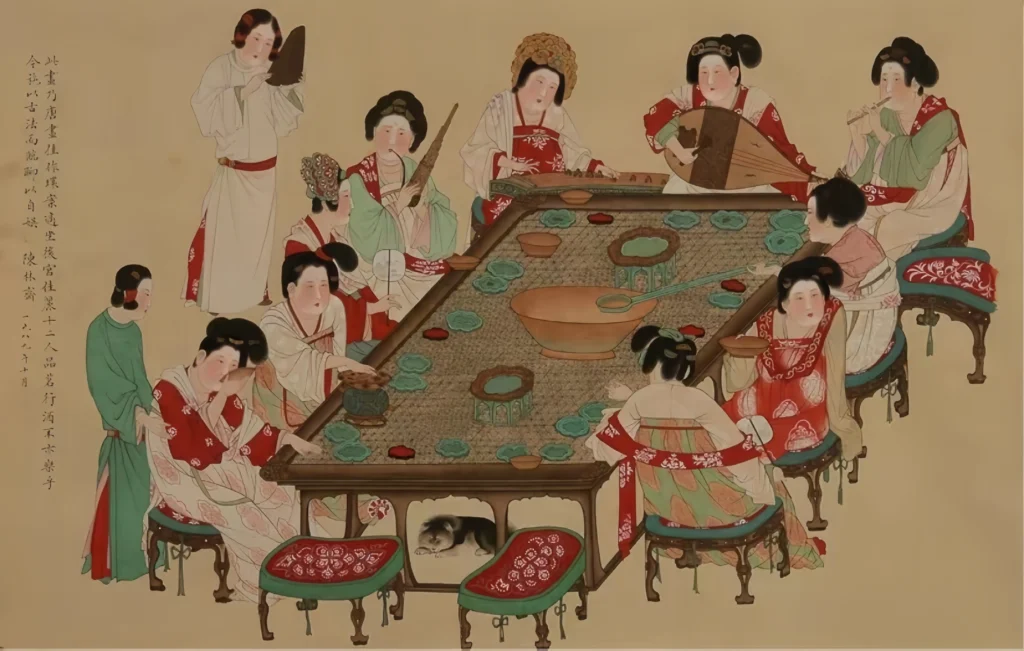
Introduction
The Tang Dynasty (618–907 CE) was a golden age in Chinese history, celebrated for its economic prosperity, cultural richness, and openness to diverse influences. Among its many legacies, Tang Dynasty clothing stands out for its elegance and vibrancy, shaping the foundation of modern Hanfu fashion. From the iconic ruqun dress to the ethereal pibo scarf, Tang attire reflects a unique blend of artistry and cultural openness. Let’s dive into five captivating styles of Tang Dynasty clothing that continue to inspire Hanfu fashion enthusiasts today.
Tang Dynasty’s vibrant Hanfu styles, known for their cosmopolitan flair, are a dazzling part of Hanfu’s legacy. Curious about their global influence? Learn more!
When it comes to Tang culture, clothing stands out as a vibrant highlight. The elaborate and graceful designs left a lasting impression on history enthusiasts, offering a deeper understanding of the splendid Tang culture and its rich Chinese aesthetic.


Women’s Clothing in the Tang Dynasty
Among Tang Dynasty fashion, women’s clothing is particularly noteworthy. Tang women’s attire was bold and open, featuring rich and varied accessories, a wide range of colors and materials, and exquisite decorative patterns. Tang clothing holds a significant place in the history of Chinese fashion.
1. Overview of Tang Women’s Clothing
During the Sui and Tang periods, China transitioned from division to unity and from chaos to stability, fostering a flourishing economy and culture. This prosperity was reflected in clothing, with both materials and styles reaching unprecedented brilliance. The most iconic women’s outfit was the ruqun (襦裙), a two-piece ensemble consisting of a short jacket (ru) and a long skirt (qun).
In the Sui and early Tang periods, women wore short jackets with narrow sleeves paired with tight, long skirts tied high at the waist—sometimes even under the armpits—secured with a silk ribbon, creating a slender and graceful silhouette. By the mid-Tang period, the ruqun became slightly looser, but the overall style remained consistent.
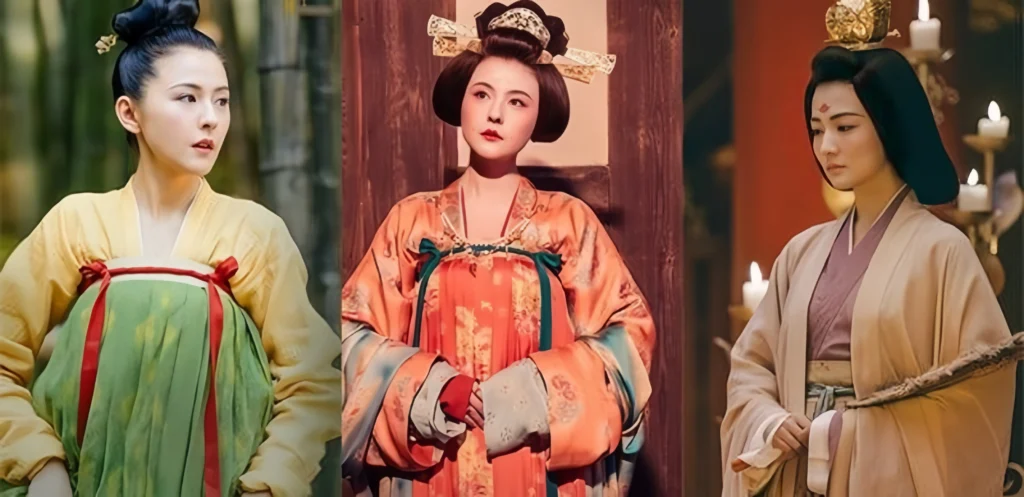
Women in the Tang Dynasty loved to dress up. The “half-arm” jacket (banbi), popularized by the imperial court, came in various styles—lapel, pullover, collared, or collarless. These jackets had elbow-length sleeves, reached the waist, and were tied at the chest with a small ribbon. Their wide necklines often revealed the upper chest, a bold and fashionable choice. The banbi remained popular over time and was later adopted by men as well.
Another fashionable accessory was the pibo (披帛), a long, sheer scarf made of gauze, often adorned with silver or gold-powdered floral patterns. One end was fixed to the chest ribbon of the banbi, draped over the shoulders, and wrapped around the arms, adding a flowing, ethereal charm to the outfit. The pibo enhanced the elegance of women’s clothing, giving it a fairy-like grace.
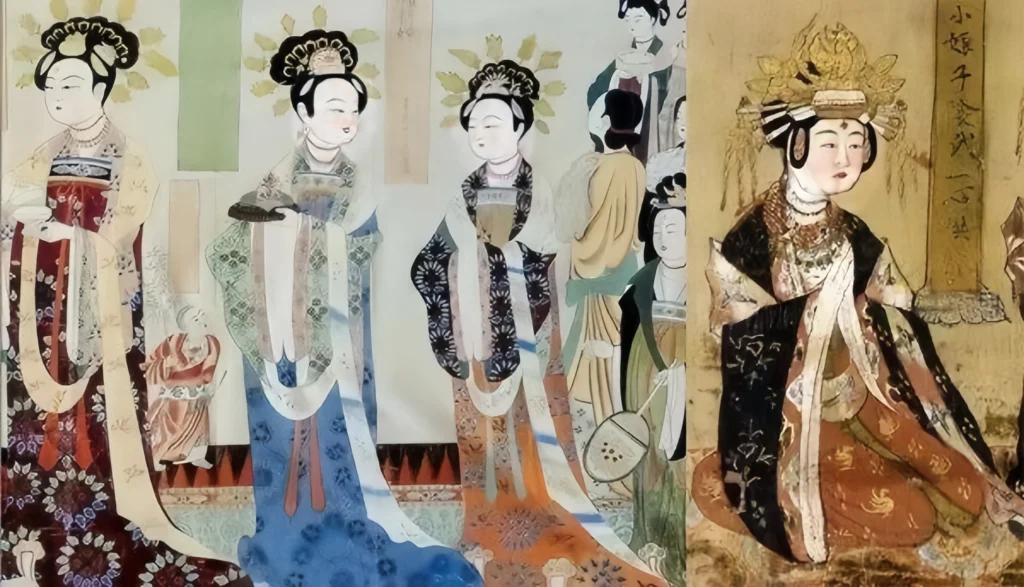
Aristocratic women’s pibo scarves were especially lavish, often embroidered with gold or silver threads. Emperor Xuanzong even mandated that pibo scarves be worn during palace banquets. The combination of a short jacket, long skirt, and pibo highlighted a woman’s figure while offering lightweight, graceful, and practical elegance.
The pibo wasn’t a Tang invention—it appeared in earlier Buddhist sculptures—but its popularity in the Tang Dynasty elevated its cultural significance, as seen in numerous sculptures and paintings of women and deities adorned with these scarves.

2. Popular Styles of Tang Women’s Clothing
Tang women’s fashion revolved around three main styles: the ruqun dress, women wearing men’s clothing, and hufu (胡服, foreign-inspired clothing). The most common ruqun styles were the chest-high skirt (qixiong ruqun) and the half-arm high-waist skirt. The chest-high ruqun consisted of a short jacket, a long skirt, and a pibo scarf.
The short jacket came in six variations: straight collar with front ties, cross-collared with right-over-left fastening, square neckline, deep U-shaped neckline, heart-shaped pullover, and V-neck pullover. Sleeves evolved from narrow to wide, offering different looks and feels depending on the style.

The chest-high skirt was tied above the waist, often at the chest, while the high-waist skirt was fastened just below the chest but above the waist. Skirts featured vibrant patterns, often with embroidery, printed designs, or subtle textures, with red being the most popular color. The half-arm jacket could be tucked into the skirt or left to drape naturally over the waistband.
Tang women faced the same wardrobe concerns as modern women, such as avoiding accidental exposure. The hezi skirt was a clever solution—a strapless dress combining a fitted bodice (hezi) with a long skirt. One way to wear it was to layer a chest-high skirt underneath, wrap the hezi skirt over it, and secure it with a waistband.
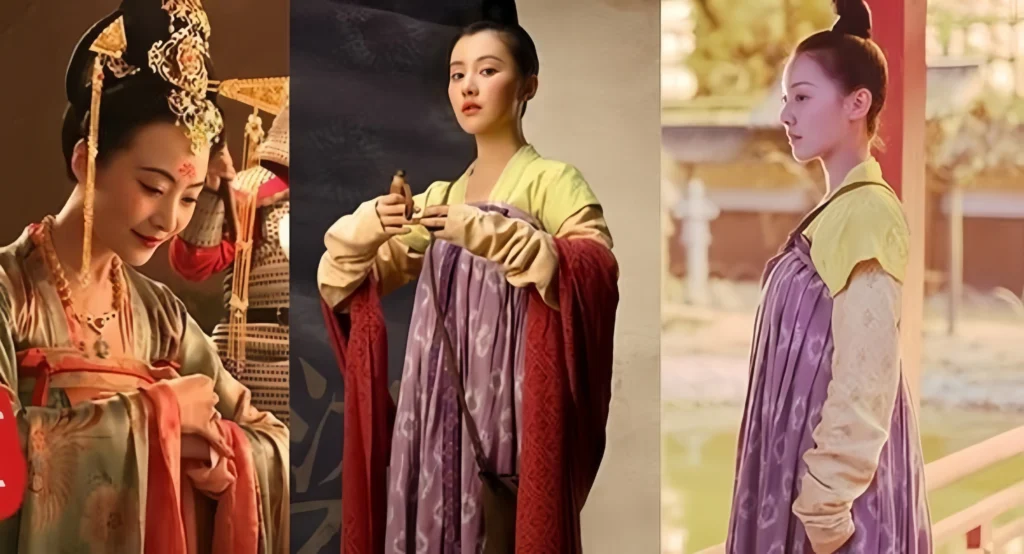
Another iconic garment was the wide-sleeved robe (daxiushan), with sleeves over a meter long and subtle slits at the hem, adding a striking design element.
Tang women embraced bold fashion, including low-cut tops that exposed the neck and partially revealed the chest. Tang poetry vividly describes this trend, with lines like “Her chest as white as snow, her face like a flower” or “Powdered chest half-hidden, like fresh snow.” These open styles reflected the era’s liberated and confident spirit.
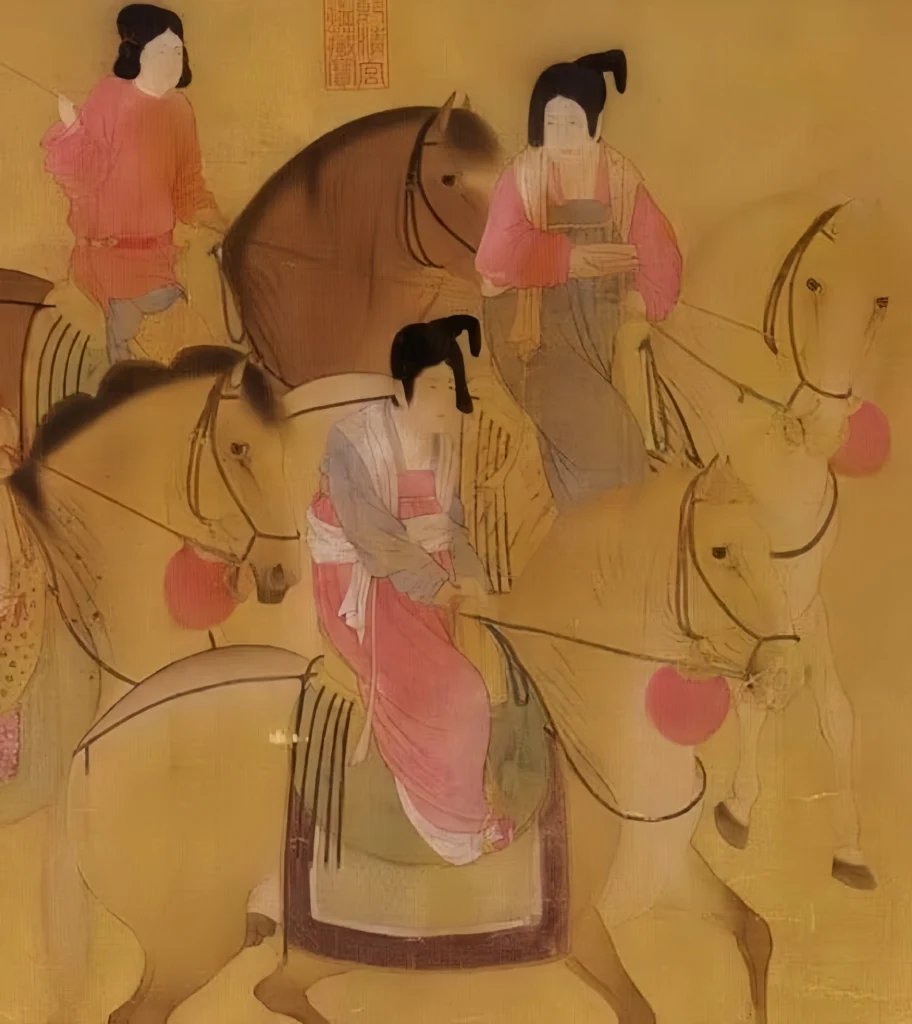
Women wearing men’s clothing was another bold trend, rare in China’s feudal history due to strict gender norms outlined in texts like The Book of Rites. Yet, in the Tang Dynasty, it became a fashionable statement, adding charm to the already colorful women’s wardrobe and showcasing the era’s openness.
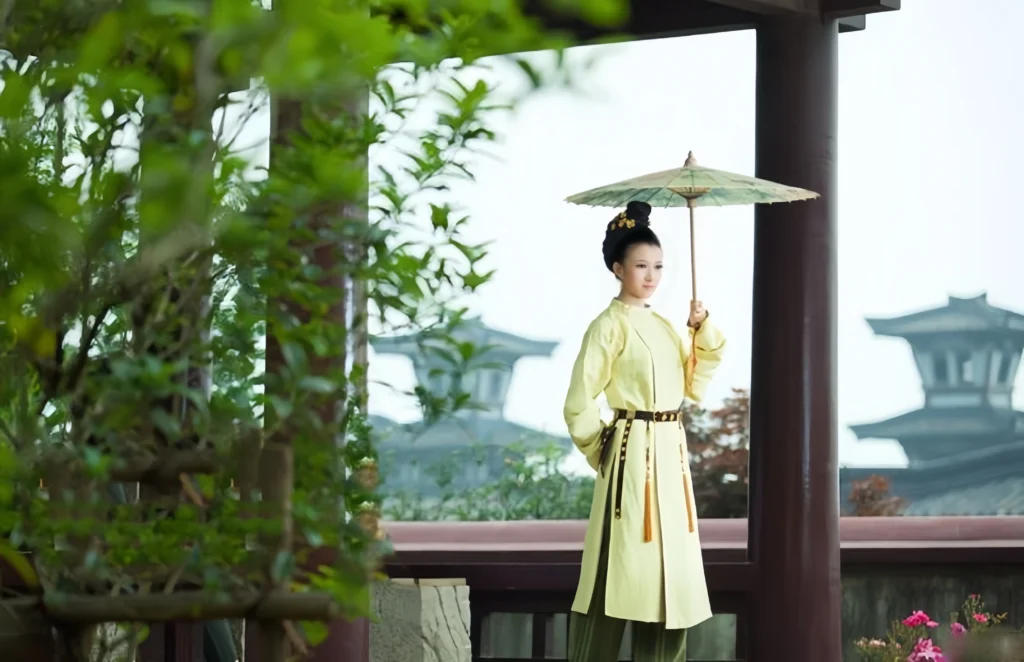
Tang women also embraced hufu, inspired by Central Asian and Persian cultures, characterized by narrow sleeves, lapel collars, and front-buttoned designs with wide, decorative borders. This style was influenced by the popularity of foreign dances, music, and performances during the Tang’s cosmopolitan era from the reign of Emperor Taizong to the Kaiyuan period (713–741 CE).

Whether in ruqun, men’s clothing, or hufu, Tang women exuded elegance and poise. Their graceful movements, adorned with swaying hairpins, flowing sleeves, and trailing skirts, made them appear like celestial beings, inspiring admiration across neighboring regions and later generations.
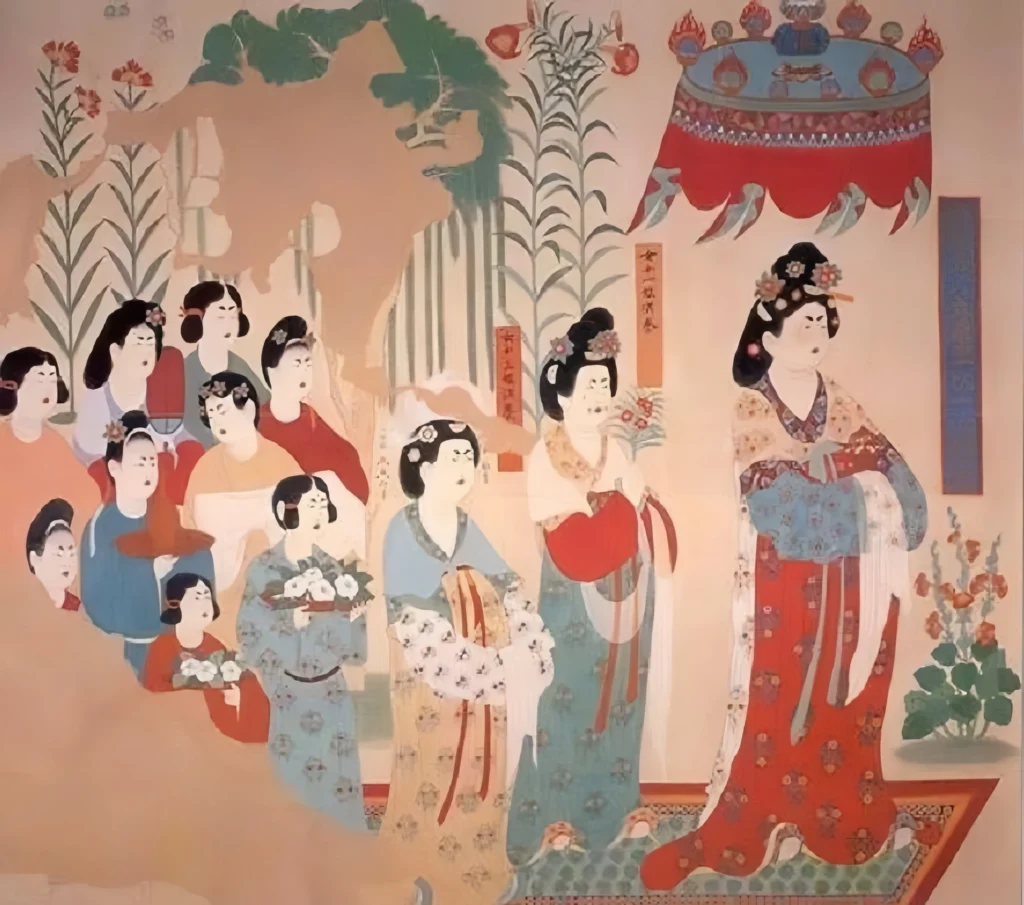

Men’s Clothing in the Tang Dynasty
Tang men’s clothing typically followed the shenyi (deep robe) style, consisting of an upper garment and a lower skirt-like section. The upper part was a round-collared robe with right-over-left fastening, featuring a horizontal band (lan) at the hem. Sleeves varied from narrow to wide. Civil officials wore longer robes, often reaching the ankles or floor, while military officials wore shorter ones, typically ending below the knees. Men paired these robes with a futou (headwrap), black boots, and a leather belt.
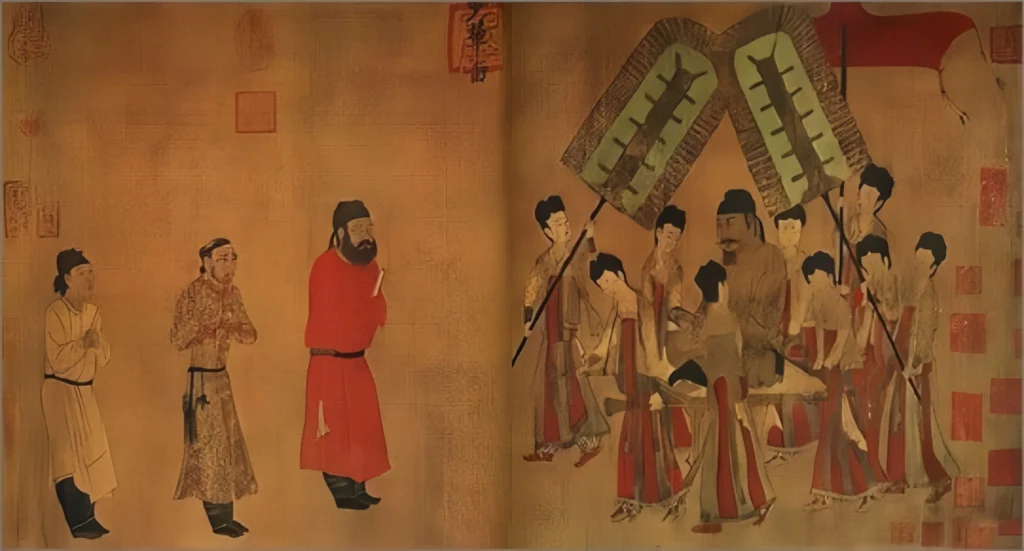
This robe style wasn’t exclusive to the Tang—it influenced men’s fashion in the Song and Ming dynasties and even traditional clothing in Korea and Japan.
The futou originated in the Northern Qi period as a gauze cap and later incorporated a hard lining to maintain its shape. Some futou were tied at the forehead with two trailing ends at the back. Emperors wore futou with upward-curving ends, while officials’ ends hung downward, becoming flat by the Five Dynasties period.
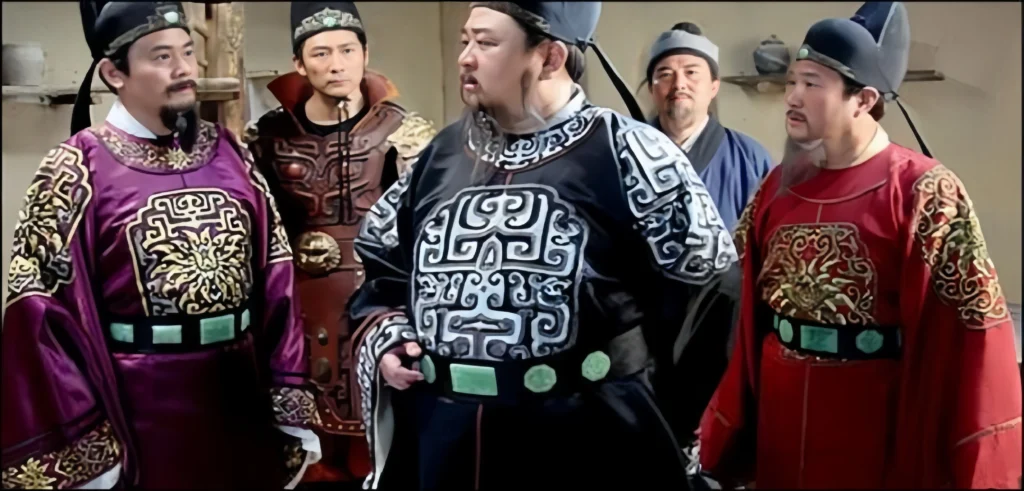
The Tang court enforced strict clothing regulations to signify rank. According to Tang Yinqi Qian, “Tang officials’ clothing colors corresponded to their rank.” The Old Book of Tang notes that from 622 CE, officials of the third rank and above wore purple, those below the fifth rank wore scarlet, sixth and seventh ranks wore green, and eighth and ninth ranks wore cyan, with belts made of brass or stone.
By 674 CE, further regulations specified: third rank and above wore purple with gold and jade belts; fourth and fifth ranks wore deep and light scarlet with gold belts; sixth and seventh ranks wore deep and light green with silver belts; eighth and ninth ranks wore deep and light cyan with brass belts; and commoners used copper or iron belts.
These color and accessory distinctions, enforced by the court, not only reflected social hierarchy but also shaped a cultural mindset around clothing.


Manufacturing Techniques, Colors, Materials, and Patterns in Tang Clothing
1. Manufacturing Techniques
Tang textile techniques included weaving, embroidery, painting, dyeing, and appliqué. Weaving produced colorful brocades and palace silks; embroidery featured vibrant five-color patterns or gold and silver threads, commonly seen in women’s clothing. Painting techniques included gold and silver designs or colorful illustrations. Dyeing ranged from single-color to multicolor tie-dye (xie), while appliqué involved cutting colored silk into patterns and attaching them to fabric.
A notable example is the Tang eight-color gradient brocade skirt fragment, where the jian technique arranged warp threads to create a gradient effect, showcasing advanced weaving skills.

2. Vibrant Colors in Tang Clothing
Tang clothing was known for its vivid colors, especially in women’s fashion, which emphasized elegance through careful color and material coordination. Women’s skirts commonly featured red, yellow, purple, and cyan, reflecting the era’s lively and passionate spirit.
During Emperor Xuanzong’s reign, Yang Guifei popularized bright yellow gauze skirts, sparking a trend across the capital.
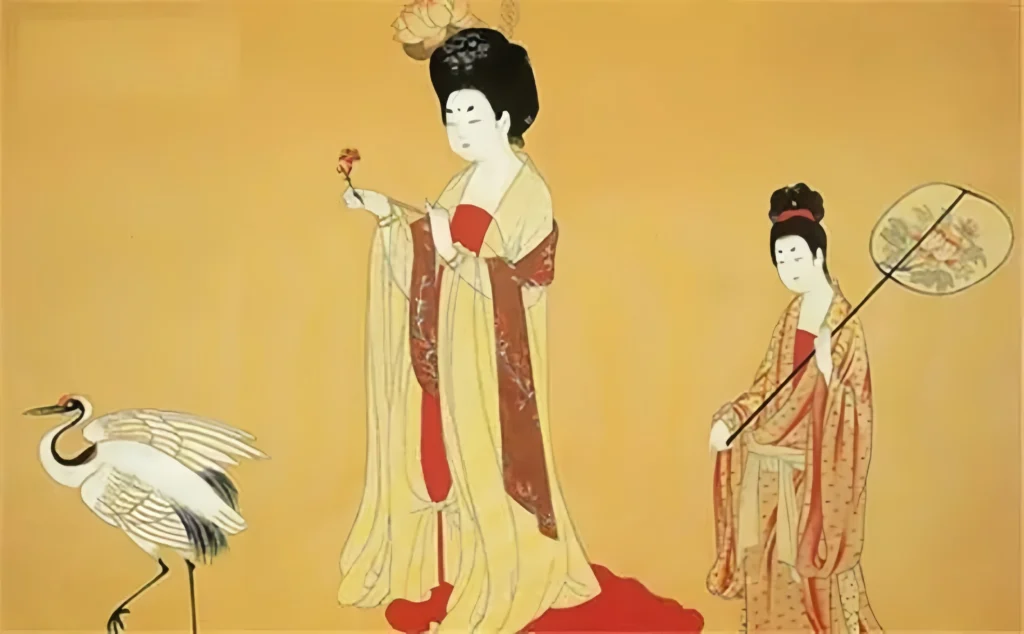
Red skirts came in shades like deep red, light red, peach red, and pomegranate red—the latter being the most fashionable, as seen in Bai Juyi’s poem, “Rowing with a magnolia oar, drinking in a pomegranate skirt,” and Wu Zetian’s “Open the chest to check the pomegranate skirt.”
These vibrant skirts, paired with varied accessories, symbolized the era’s prosperity and advanced textile industry.
3. Diverse Materials in Tang Clothing
Tang clothing used a wide range of materials, including silk, brocade, cotton, and lightweight gauze (sha) and sheer silk (luo). These soft, comfortable fabrics supported intricate techniques like printing, jacquard weaving, and embroidery, resulting in both ornate and simple yet elegant designs.
Gauze was a key element in women’s clothing due to its lightweight, translucent quality, creating a dreamy, cloud-like effect when layered. Typically, women wore silk or brocade as a base layer, with gauze adding a delicate, ethereal touch. The interplay of thick and thin, heavy and light materials created a harmonious, layered look.
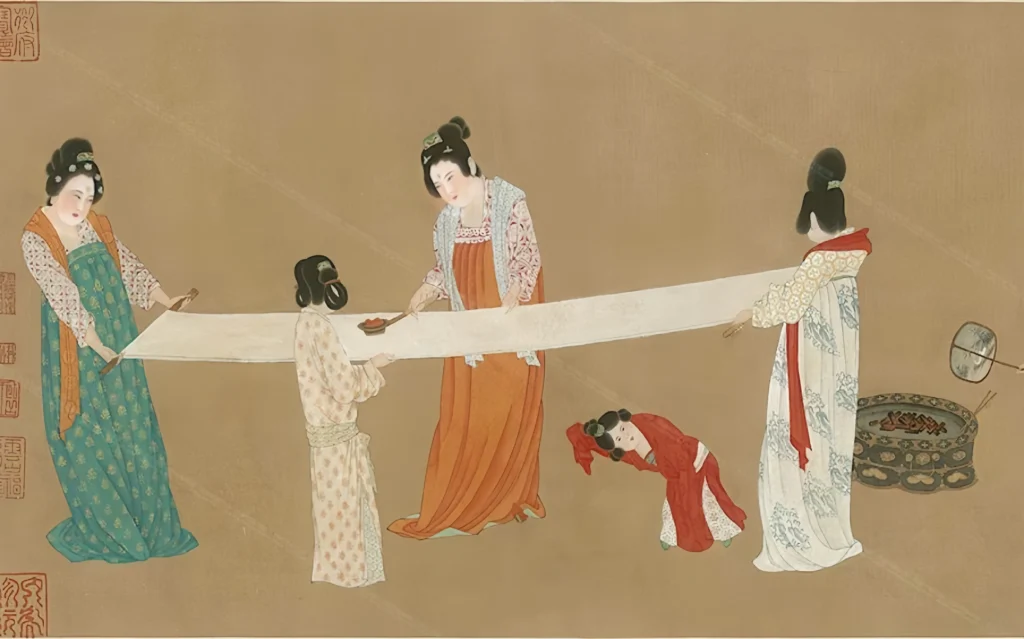
One luxurious material was peacock silk (kongque luo), a finely woven fabric with a glossy finish, epitomizing Tang textile artistry.
The fabric determines the versatility of clothing in both design and styling. Tighter weaves are stiffer, making them easier to shape but less drapey and lightweight. Looser weaves, on the other hand, are softer, lighter, and more breathable, often used as accents or complementary elements in outfits.

4. Intricate Patterns in Tang Clothing
The quality of a fabric’s texture and breathability determined its value, but patterns were equally significant in Tang clothing culture. Common motifs included baoxianghua (treasure flowers), small clustered flowers, and chanzhihua (entwined branch flowers), visible in unearthed artifacts and Tang paintings.
Baoxianghua: Large, vibrant flowers like peonies, lotuses, or pomegranates, often paired with chrysanthemums, arranged in symmetrical, layered patterns. These motifs, derived from Buddhist art, symbolized wealth and happiness.
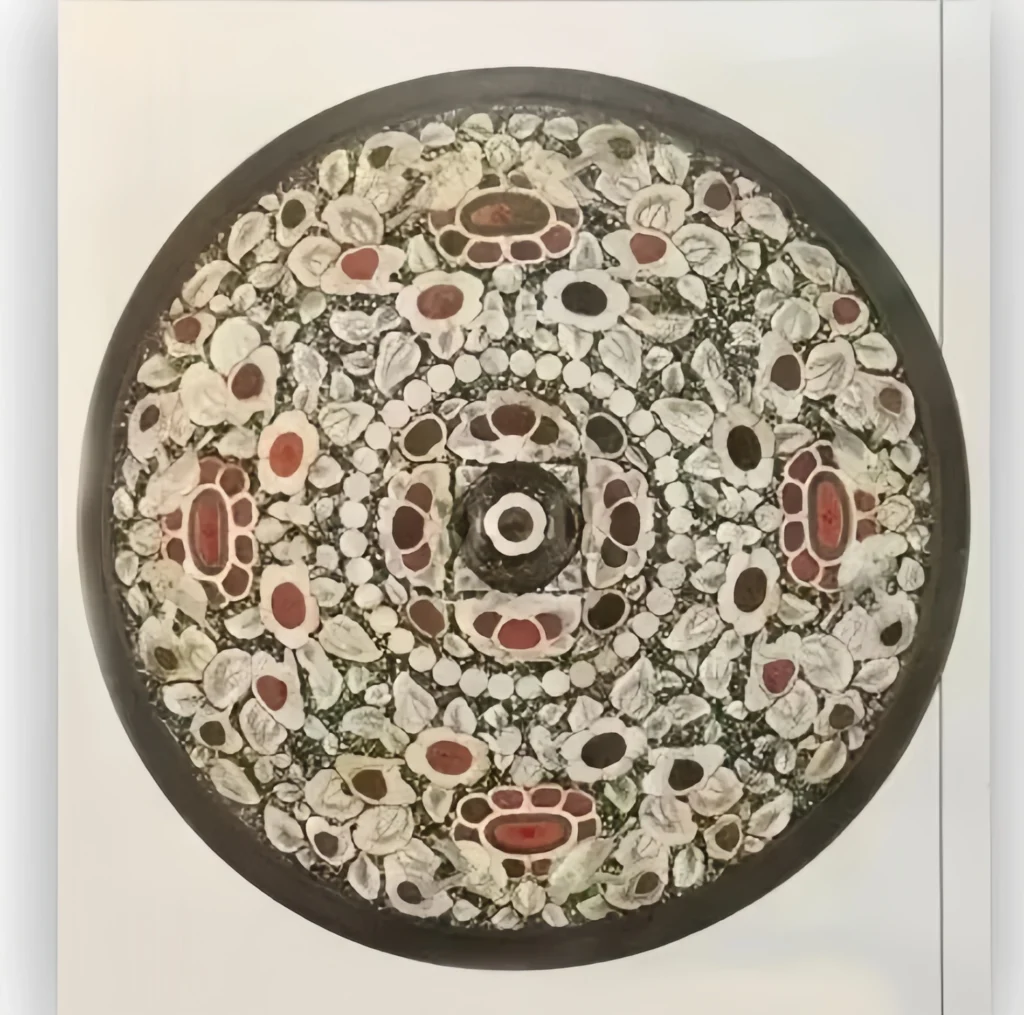
Small Clustered Flowers: Symmetrical, round flower clusters, sometimes with stems and leaves, used as decorative accents on ruqun and pibo, adding depth and elegance.
Chanzhihua: Flowers and leaves intertwined with vines, creating a dynamic, flourishing pattern that remains popular in modern fashion.
Zhou Fang’s painting Ladies Wearing Flowers in Their Hair captures Tang aristocratic women in sheer gauze robes with flowing skirts, adorned with baoxianghua and chanzhihua patterns. The artwork highlights the interplay of dense silk and translucent gauze, showcasing Tang textiles’ luxury and finesse.

Men’s clothing, especially for officials, followed strict color codes. Before the Tang, yellow was widely used, but from Emperor Gaozong’s reign, it became exclusive to the emperor. Official robes used purple for third rank and above with large floral patterns, scarlet for fifth rank with small floral patterns, yellow (lemon shade) for sixth rank with geometric patterns, green for seventh rank, and cyan for ninth rank, each with specific belt materials.For more on Tang men’s attire, visit the Metropolitan Museum of Art’s Asian Art Collection
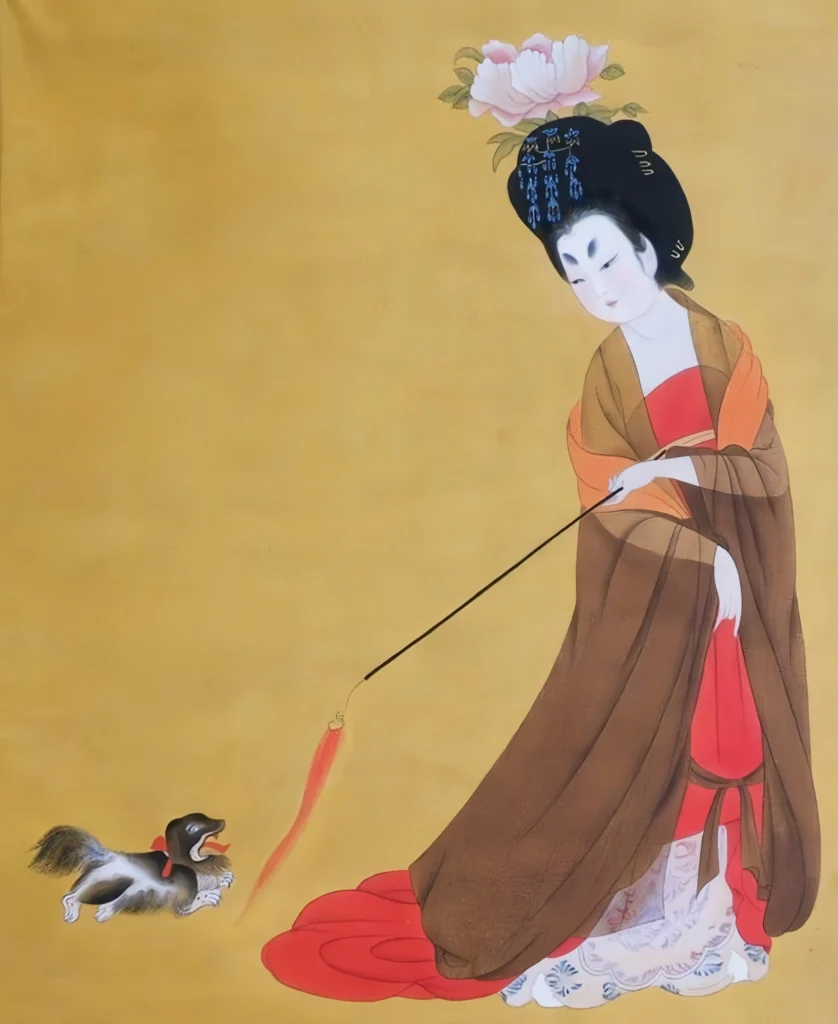
Tang Dynasty men’s clothing was strictly regulated by the rank of court officials, with specific color requirements. Before the Tang, yellow clothing was worn by all social classes, but during Emperor Gaozong’s reign, yellow was prohibited for officials and commoners, with ochre yellow reserved exclusively for the emperor.
The prescribed colors for officials’ regular clothing were as follows: princes and officials of the third rank and above wore purple silk with large floral patterns and jade belt hooks; those above the fifth rank wore vermilion silk with small floral patterns and gold-plated belt hooks; sixth-rank officials wore lemon-yellow silk with geometric patterns and rhinoceros horn belt hooks; seventh-rank officials wore green silk with geometric patterns and silver ring belt hooks; ninth-rank officials wore cyan silk with jade stone belt hooks.
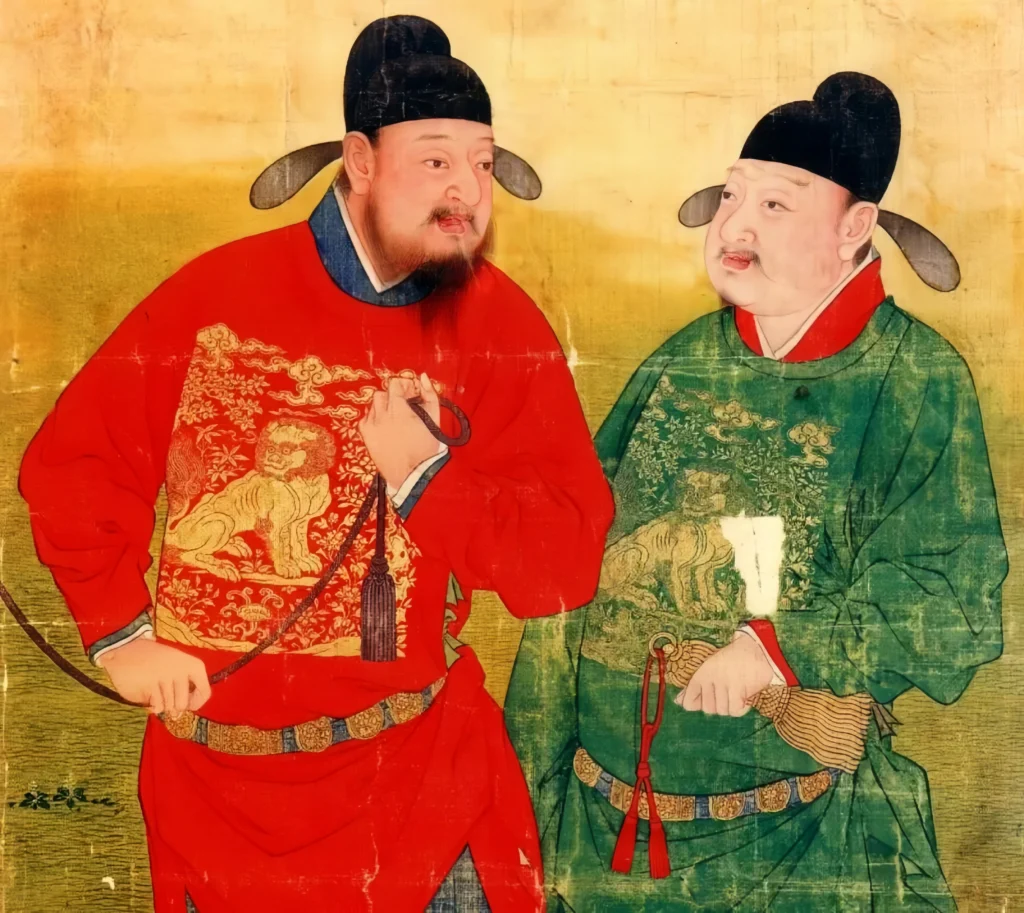
The Tang’s hierarchical clothing system had a profound influence on later dynasties like the Song and Ming, as well as on minority-ruled regimes such as the Liao and Yuan, which adapted these regulations with modifications.
Conclusion
The Tang Dynasty excelled not only in economics and culture but also in the art of clothing. These artistic achievements fueled economic growth, creating a cycle of mutual enhancement that made the Tang one of China’s most prosperous feudal eras.
Immersing ourselves in the rich, inclusive, and liberated Tang clothing culture feels like stepping back into a time of natural elegance and open-mindedness. It evokes the vibrant spirit of the High Tang, stirring a sense of awe and joy that resonates deeply within us.
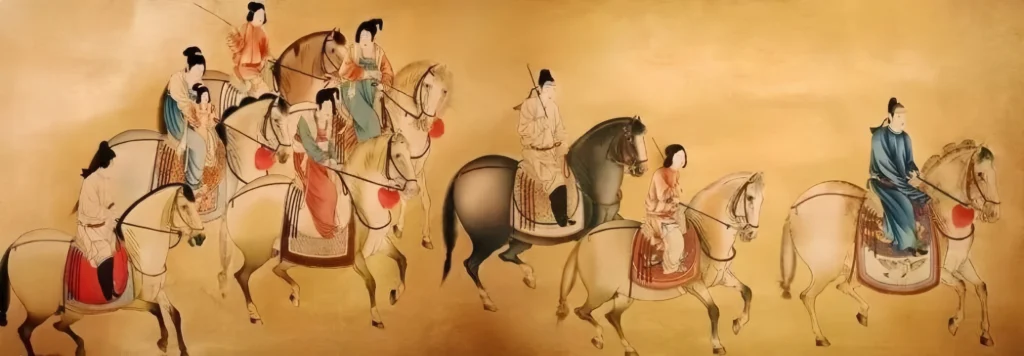
Why Tang Dynasty Clothing Matters Today
The vibrant colors, intricate patterns, and innovative designs of Tang Dynasty clothing continue to captivate Hanfu fashion enthusiasts worldwide. From the flowing pibo scarf to the elegant ruqun dress, these styles embody a cultural legacy of openness and artistry. The Tang Dynasty’s advanced textile techniques, such as gradient brocade and gold-thread embroidery, showcase a level of craftsmanship that inspires modern designers. Whether you’re exploring Hanfu fashion for a festival or a photoshoot, Tang-inspired clothing offers a timeless connection to China’s golden age.
Ready to embrace Tang Dynasty clothing? Start with a ruqun dress or pibo scarf from reputable online stores like Hanfu Story and bring the elegance of the Tang era to life. Share your favorite Tang women’s attire styles in the comments below, and let’s celebrate the enduring beauty of Hanfu fashion!
The Tang Dynasty fashion’s opulence is vividly captured in ancient artworks.



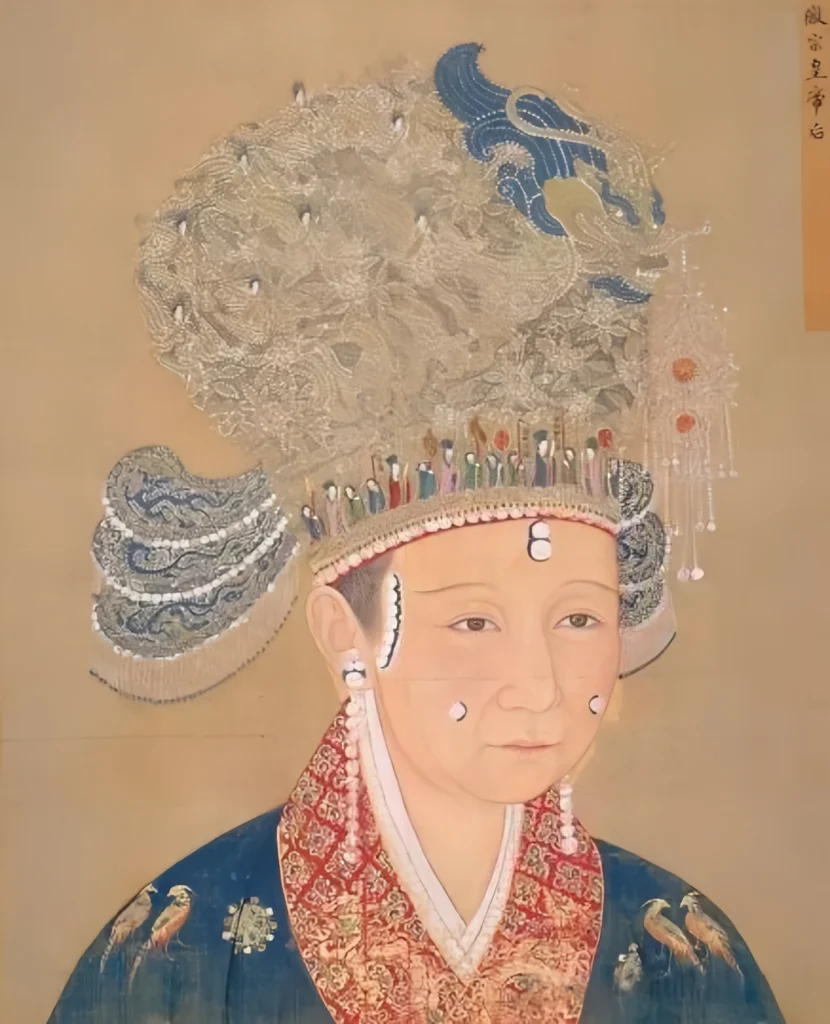

Responses